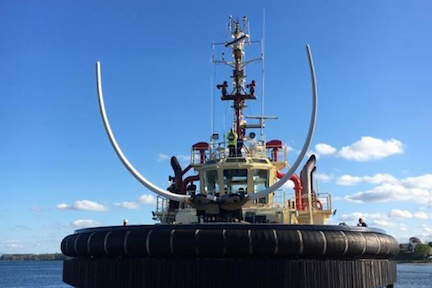The following is text of a news release from Svitzer:
(COPENHAGEN) — Svitzer, a leading global towage operator, has begun landmark sea trials of a new "industry-first" remotely operated line-catching technology prototype.
The new innovative mechanism is being trialed on the vessel Svitzer Trym, in the company’s Scandinavian fleet, and could significantly improve safety standards and reduce risks for crews during the process of connecting with other vessels, one of the most critical elements of towage operations.
Connecting heaving lines at sea is one of the most critical parts of day-to-day towage operations, and one which presents significant risk to crews, particularly from a center lead forward position where the tugs must operate very close to the connecting vessel. This is further influenced by other factors including wind, sea state, and the increasing size of vessels, where the distance from the tug is significantly greater and requires more accurate throwing.
Svitzer’s new prototype line catcher is remotely and safely operated from the wheelhouse and catches and secures the connecting vessel’s heaving line. With a wingspan of between 6 and 7 meters (19.5 and 23 feet) when activated, the crew on the connecting vessel has a larger target area to hit with the heaving line weight, and no member of the tug’s crew is exposed during the process. As well as enhancing safety standards, the automated catching arm prototype is also designed to increase the success rate of connecting the vessel to the tug, leading to safer and more efficient operations.
Svitzer’s technical team in Copenhagen has been developing the remote line-handling technology for the past year, and it will now be installed and tested over the coming months on Svitzer Trym to prove the concept. This will include documenting and analyzing performance in a live operational environment and recording how the technology is impacted by weather and other factors so that potential improvements can be made to further enhance safety and efficiency. The testing process will also define clear requirements and standards that will need to be implemented for the training of crews in effectively and safely operating the remote line catcher.
The installation is being conducted in consultation and with final approval from leading classification society, Lloyd’s Register.
“At Svitzer safety comes first, and we have an obligation and duty of care to constantly look and evaluate how we can further improve safety standards for our crews, and increase efficiencies within our operations for our customers," said Leonardo Sonzio, chief operating officer, Svitzer Global. "Catching and securing a vessel’s heaving line is a key area that has always presented significant risk for towage operator crews. We have therefore spent considerable time and resource over the past year looking at how we can make a difference, and while we may be at the testing phase, we are hopeful that this new line handling technology is the step-change that is required, and will set a new benchmark for safety excellence within the market.”
“The shipping industry is rapidly changing, and in particular using new technologies and innovations as part of its continued drive to deliver more sustainable, efficient and safer operations," he said. "The towage sector must also evolve accordingly, developing and improving to meet the changing requirements of its customers, and safeguarding the safety and well-being of the crews that operate on the front line. We know there is power in being a first mover and we do not want to sit still, particularly when our actions as an organization can secure jobs in the future, and directly improve safety for our people and efficiency for our customers.”

